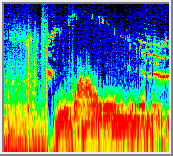|
COMETS EARTH JUPITER KUIPER BELT MARS MERCURY METEORITES NEPTUNE OORT CLOUD PLUTO SATURN SOLAR SYSTEM SPACE SUN URANUS VENUS ORDER PRINTS
PHOTO CATEGORIES SCIENCEVIEWS AMERICAN INDIAN AMPHIBIANS BIRDS BUGS FINE ART FOSSILS THE ISLANDS HISTORICAL PHOTOS MAMMALS OTHER PARKS PLANTS RELIGIOUS REPTILES SCIENCEVIEWS PRINTS
|
Related Document
Download Options
"Sounds from Space:" A Video and Audio Representation of PWS Observations from the Galileo Ganymede Encounter On June 27, 1996, the Galileo spacecraft made the first flyby of Jupiter's largest moon, Ganymede. The Plasma Wave Experiment (PWS), using an electric dipole antenna, recorded the signature of a magnetosphere at Ganymede. This is the first example of a magnetosphere associated with a moon. The PWS data are represented here as both sounds and a rainbow-colored spectrogram. Approximately 45 minutes of PWS observations are transformed and compressed to 60 seconds. Time increases to the right and frequency (pitch) increases vertically. Color is used to indicate wave intensity, red corresponding to strong waves, blue corresponding to weak waves. The audio track represents the PWS data and is synchronized with the display of the rainbow-colored spectrogram. The pitch of the sound is reduced by a factor of 9 from the measured frequency and follows the location of the signal on the rainbow-colored spectrogram. The entrance into the Ganymede magnetosphere is marked by a strong burst of noise about 6-10 seconds into the recording. As the spacecraft approaches Ganymede, an irregular tone can be heard rising in frequency, reaching a peak and then declining. The pitch of this tone is a measure of the density of charged particles near Ganymede. Both the plasma wave and magnetometer data show that a strong magnetic field exists around Ganymede. Animation is courtesy of the Galileo Plasma Science Team. Launched in October 1989, Galileo entered orbit around Jupiter on December 7, 1995. The spacecraft's mission is to conduct detailed studies of the giant planet, its largest moons and the Jovian magnetic environment. The Jet Propulsion Laboratory, Pasadena, CA manages the mission for NASA's Office of Space Science, Washington, DC. |
